How to make a lift plan! – Blog Post
“HELP!!!! I don’t have treadles!!!!!”
If you have a direct tie-up loom or a table loom, you need to create a lift plan from the draft to know how to weave the fabric. A lift plan combines the tie up and treadling to tell you exactly which harnesses go up for each pick. It is a great way to see and feel how the cloth grows, often in a more tactile and immediate way than with all the harnesses tied up to the treadles. You decide which harnesses are going up for each pick.
Creating a lift plan from a draft with a Tie-up and treadling can seem like a daunting task, but the steps are really simple and straight forward.
Let’s start with the simplest draft, plain weave on 4 harnesses.
As with any weaving draft, there are 4 parts to the draft:
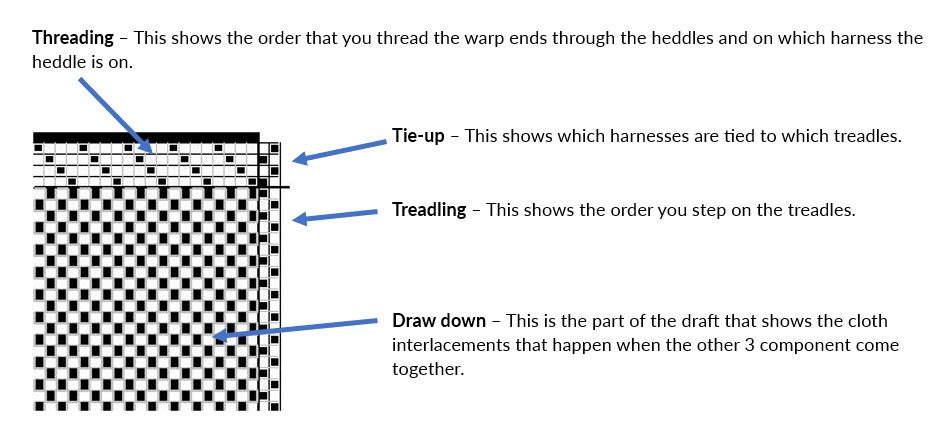
In a standard draft the tie-up has harness 1 & 3 tied to the first treadle and harness 2 & 4 tied to the second treadle. To make plain weave fabric, alternate between treadle 1 and treadle 2.
The Tie-up section in a lift plan shows each harness tied to a separate treadle or lever. This is how your table loom or direct tie-up loom works. The Treadling section shows the combinations of levers or treadles that need to be used to create each shed.
In our plain weave example, for the first pick, you will need to lift harness 1 and harness 3 and then throw the first pick. Then, lift harness 2 and harness 4 and throw the second pick. We represent the lift plan as a list of the harness combinations like this:
- 1,3
- 2,4
Or, we can represent the lift plan as a draft:
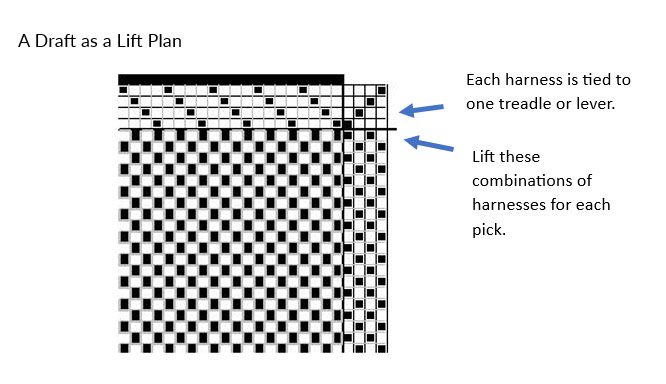
And just as a comparison, here is the original draft shown next to the lift plan.
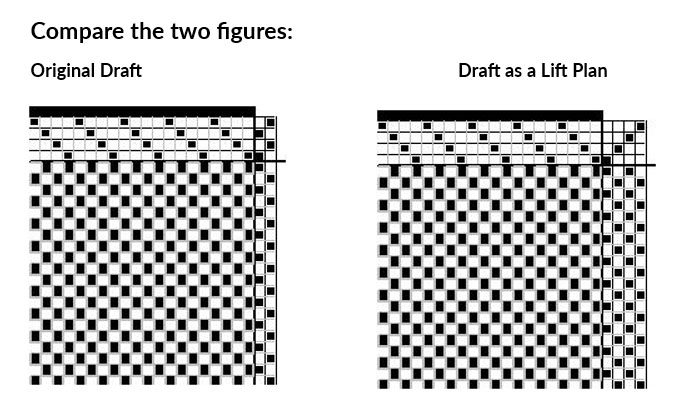
Now let’s see how to do it with a twill.
Here is a weaving draft with a treadling and tie up for a 4-harness straight twill:
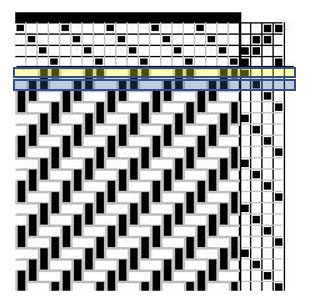
To create the first shed (shown in yellow in the draft), you need to use treadle one. From the tie-up, you see that the first treadle tells you to lift harness 1 and 2. On the lift plan with each harness individually tied up, the first “treadling” line of your lift plan shows that you raise harness 1 and 2. The next shed in the draft (shown in blue in the draft) shows that you use treadle two. This will raise harness 2 and 3. On the lift plan, the second shed shows that you raise harness 2 and 3. The next line shows that you raise harness 3 and 4 and the last line of the repeat shows that you raise harness 1 and 4. The drawdown portion of both drafts should show the same fabric. If they do, you know the lift plan is correct.
Again, here are the two drafts side by side:
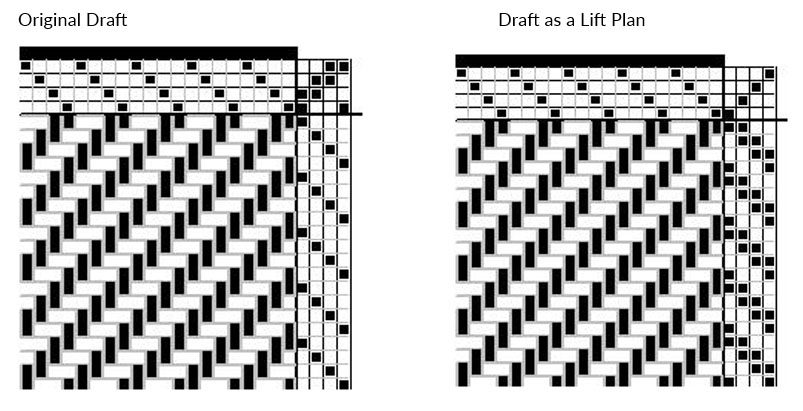
Keep going!
And just to show how far you can go with this, here is an 8-harness, broken twill boxes draft using treadles:
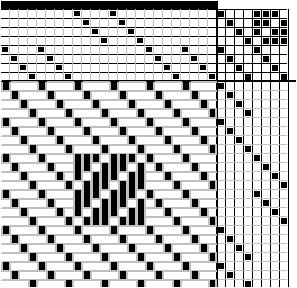
Looking at this draft, the first pick lifts harness 4 and 8, the second 3 and 7 and so on.
Now let’s look at the 8th pick, where you lift harness 4, 6,7, and 8. Too much for feet, but wonderful on a table loom or to send to the computer dobby. You create the lift plan just the same way that you do if it has just two harnesses with each pick.
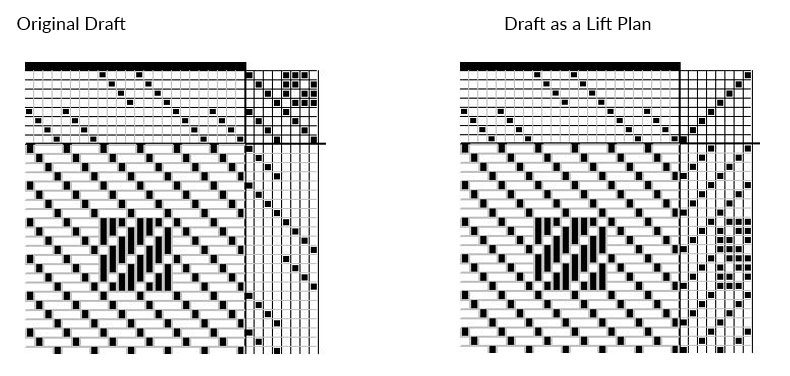
It can be helpful on more complicated patterns like this one to write out the lifting sequence:
- 4, 8
- 3,7
- 2,6
- 1,5
- 4, 8
- 3,7
- 2,6
- 1,5
- 4,6,7,8
- 3,5,7,8
- 2,5,6,8
- 1,5,6,7
- 4, 8
- 3,7
- 2,6
- 1,5
- 4, 8
- 3,7
- 2,6
- 1,5
One More Time!
Here is part of the Turned Tacquete draft used in the Toasty Turned Tacquete Cowls. You really can turn any draft into a lift plan!
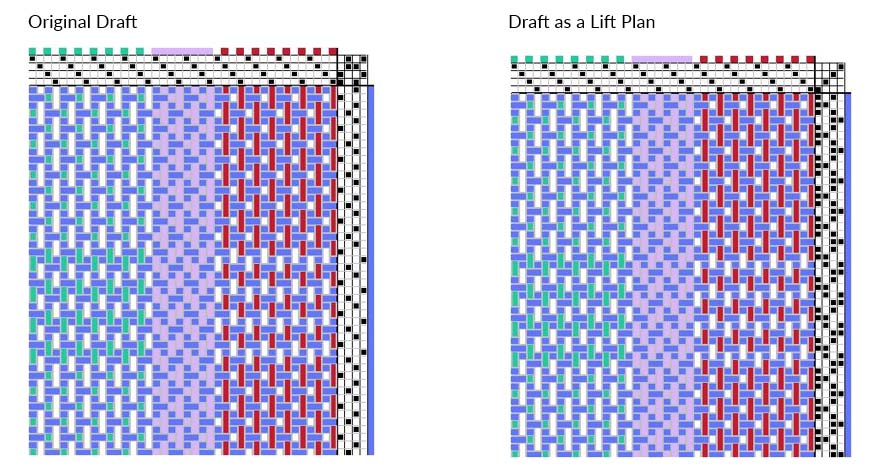
Treadling and tie-ups and lift plans have their place, now you can choose which is right for your project and your loom!
Most drafting software has an option to turn any tie-up and treadling draft into a lift plan. But aren’t you glad you now know how to do it without software!


Thank You! I’ve been a weaver for nearly 10 years, and I use both a treadle loom and a direct tie-up, table loom. Recently a friend of mine has taken up weaving, too, and is struggling to understand how read a pattern and translate it to her new table loom. I’ve tried to show her, but I can sense she is still confused. This post is perfect. I think it will be just what she needs to get beyond her confusion and frustration, and into the joy of weaving.